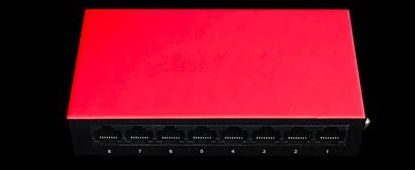As of mid 2018, it is clear that network streaming, whether from locally stored files, or via streaming services, has over taken optical disc playback for high end hobbyists. Don’t get us wrong, plenty of folks still open the well on their CD, DVD, or SACD players and insert discs, and there is certainly nothing wrong with that. But high resolution downloads and the ability to rip SACDs easily now has made network playback all too convenient, and some would say, superior sonically, although we take no stand on that.
The Ethernet pipeline as a source has matured to the point that there are many products that have come to market in a similar way that unfolded for USB. When computer audiophiles started to be concerned about “galvanic isolation”, USB quality, and data integrity, a whole cottage industry of fixes sprang up. We saw USB “purifiers”, re-clockers, isolators, USB cable with split data and power leads. You name it, it appeared.
Because it is now widely believe that USB as a pipeline does have considerable issues, many of these products did indeed improve the sound. We found the Intona USB Isolator was the best of the bunch and when placed between the network file player and DAC paid sonic dividends. The unit also seems to have good synergy with Wireworld USB cables.
As with USB, Ethernet purifying solutions have sprung up faster than weeds. It is fair to say that many of these types of products have been used in mission critical industries for decades, for instance in military and medical settings. For audiophile applications, opto isolators have become very popular, and are a cost effective way to reduce noise and any potential interference. Other approaches include LAN isolators with transformers built in, and we even no have “audio grade” networking cables.

We have used some of these products in our systems, and devices from SOtM, Acoustic Revive, and even units from non audio companies like Emo Systems have made positive differences. Audiophile grade networking hardware has entered a relatively new era with routers and switches being designed specifically for audio use. One such company, The Linear Solution, sent me their TCXO switch to spend some time with. The company also makes routers, power supplies, LAN cables, and computer cards. The TCXO is $429, with the linear power supply additional.
We have two complete networked systems, and several streamers used as Roon end points, including the Sonore microRendu, and a Bryston BDP-2. There is also a Simaudio MiND DLNA streamer in the mix. Everything is hooked up via Ethernet, with various Apple iPads as control points. WiFi for the control points is supplied by Google WiFi modules.
Listening to music from the networked library with the Linear Solution switch in the path resulted in a very stable connection, with no dropouts, glitches, or any other issues. This was regardless of resolution, from Redbook CD to DSD128. The system sounded excellent, and whether the TCXO switch was responsible or not, it is hard to say, but the noise floor certainly was very low, and just removing a cheap wal wart power supply from the mix has to have benefits.

The Linear Solution switch is very nicely made, feels like an industrial grade product, and according to the company, is made with higher grade parts than any off the shelf unit. We cannot promise that these products will for sure improve the sound of your system, but they will create less unwanted noise. We would strongly suggest contacting the company with any questions. Computer audiophiles looking to go the extra mile should without a doubt take a look at these products.
Q&A with The Linear Solution:
Q) For digital audiophiles, playback of of digital files via network seems to have become the standard. How important is the configuration of the network with respect to audio?
A) The best approach to a configuration of the network is simplicity, that is the key. A simple and a separate network connection is best. A separate linear power supply for each component should be used as well.
In our opinion, it is best to avoid All-in One devices for your networking audio set up. Because those device tent to create tons of unwanted noise.
Q) How are your networking products superior to consumer grade products? What were your design principles and goals?
A) Our network switch was created with audiophile networking audio in mind from the beginning. We understand the jitter and noise interference, therefore, we spent quite a long time to improve the data accuracy , reduce jitter and noise interference.
The Linear Solution:
TCXO Switch– Specifications
– 2oz Copper
– PCB +/- 1.0ppm
– Ultra low Jitter <1ps RMS
– 9V DC input 2.1mm x 5.5mm
LINEAR POWER SUPPLY – Specifications
– AC 120V, 60Hz
– 9V Ouput
– Oyaide DC connectors
– Furutech IEC
